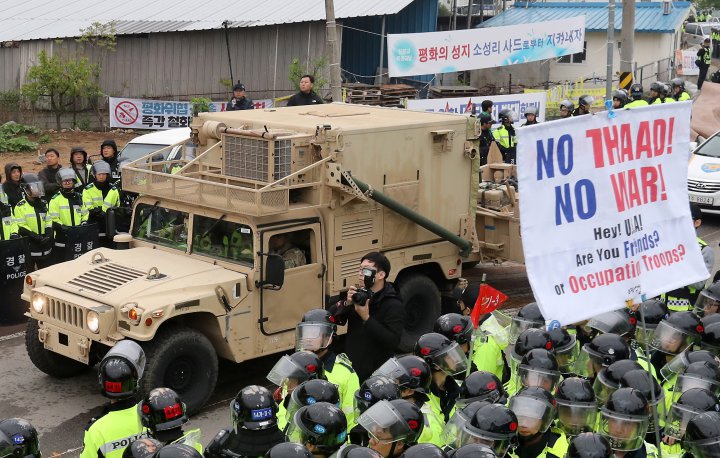South Korean officials announced on Wednesday that the installation of key components of the U.S. sourced THAAD missile defense system had successfully been installed ahead of schedule due to concerns about the potential for a North Korean attack.
“South Korea and the United States have been working to secure an early operational capability of the THAAD (which stands for Terminal High Altitude Area Defense) in response to North Korea’s advancing nuclear and missile threat,” the ministry said in a statement. The THAAD is not scheduled to be operational within this year.
The accelerated timeline for deployment of the THAAD system brought with it another round of protests by locals in the region, as well as harsh criticism from China, who claim the advanced radar system the THAAD is equipped with could be used to spy on Chinese troops and equipment. However, their most recent bout of complaints neglect to mention their concerns about American eavesdropping, instead choosing to focus on how deploying the THAAD system could further increase tensions with Kim Jong Un’s North Korean regime.
“China strongly urges the United States and South Korea to stop actions that worsen regional tensions and harm China’s strategic security interests and cancel the deployment of the THAAD system and withdraw the equipment,” Chinese foreign ministry spokesman Geng Shuang told a briefing.
“China will resolutely take necessary steps to defend its interests,” Geng said, without elaborating.
The THAAD missile defense system is a purely defensive piece of equipment. The platform uses missile-like projectiles that are not equipped with explosive warheads, but are designed to track, intercept and destroy ballistic missiles when launched.
Despite the THAAD’s defensive nature, protests broke out in the region surrounding the former golf course that will now house the missile defense platform, caused in large part by concerns that its deployment will further destabilize relations between North and South Korea. As many as two hundred protesters were said to arrive on the scene on Wednesday, and according to the protest organizers, ten were injured in run ins with local police.
“There’s still time for THAAD to be actually up and running so we will fight until equipment is withdrawn from the site and ask South Korea’s new government to reconsider,” Kim Jong-kyung, a leader of villagers opposing the deployment, said to the media.
Despite local opposition, most within the South Korean government see the deployment of the THAAD System as a prudent measure amidst increasingly aggressive rhetoric coming from the North Korean regime. Although some may worry about the way the THAAD will be perceived by China and North Korea, U.S. and South Korean defense officials seem far more concerned with the possibility of a nuclear strike being launched at the command of the North’s despotic Supreme Leader.
North Korea, ever emboldened by international efforts to dissuade them from pursuing a nuclear arsenal, once again rebuked U.S. military equipment in the region – to include the USS Carl Vinson carrier strike group currently en route to the Korean peninsula, as well as the arrival of the Ohio Class nuclear submarine the USS Michigan that docked in South Korea on Tuesday.
“It is a wild dream for the U.S. to think of depriving the DPRK of its nuclear deterrent through military threat and sanctions. It is just like sweeping the sea with a broom,” the North’s Korean Central News Agency cited a foreign ministry spokesman as saying.
Already have an account? Sign In
Two ways to continue to read this article.
Subscribe
$1.99
every 4 weeks
- Unlimited access to all articles
- Support independent journalism
- Ad-free reading experience
Subscribe Now
Recurring Monthly. Cancel Anytime.
A briefing on the North Korean threat for all one hundred members of the U.S. Senate is scheduled to take place at the White House on Wednesday, presided over by the likes of Secretary of State Rex Tillerson, Defense Secretary James Mattis, Director of National Intelligence Dan Coats, and General Joseph Dunford, chairman of the Joint Chiefs of Staff.
Image courtesy of Reuters











COMMENTS
You must become a subscriber or login to view or post comments on this article.